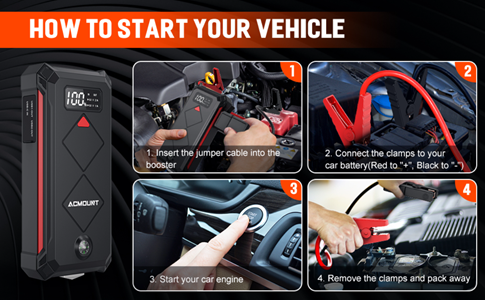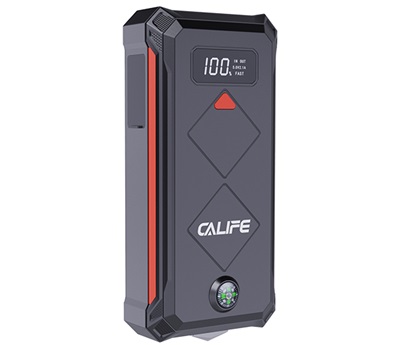In the midst of our busy lives, few things are as inconvenient as a car with a dead battery. Whether you’re stranded on a deserted road or just trying to get to an important appointment, a dead battery can quickly turn into a major headache. Fortunately, with the advent of power bank jump starters, there’s a reliable solution right at your fingertips. These compact yet powerful devices can jump-start your car without the need for another vehicle, providing a much-needed lifeline in times of trouble. In this detailed guide, we’ll walk you through the process of using a power bank jump starter to get your car back on the road, ensuring you’re prepared for any unexpected battery failures.
Power bank jump starters are compact devices equipped with lithium-ion batteries and built-in jumper cables, designed specifically to jump-start vehicles with dead batteries. Unlike traditional jump-starting methods that require the assistance of another vehicle, power bank jump starters offer a self-contained solution, making them invaluable tools for emergency situations. With their portable design and user-friendly interface, these devices empower drivers to regain mobility and overcome unforeseen battery failures with ease.

Preparation: Begin by ensuring that both the power bank jump starter and your vehicle’s ignition are turned off. Take a moment to locate the car battery and familiarize yourself with the terminals, ensuring clear access to both.
Connection: With the preparation complete, connect the red clamp of the jumper cable to the positive terminal (+) of the car battery. The positive terminal is typically marked with a “+” symbol or colored red. Next, attach the black clamp of the jumper cable to a grounded metal surface on the vehicle, such as a bolt or unpainted metal component, away from the battery.
Activation: Once the jumper cables are securely connected, switch on the power bank jump starter and wait for it to indicate readiness. Most jump starters feature LED indicators or display screens that provide status updates on battery level and readiness.
Start the Engine: With the power bank jump starter activated, attempt to start the car engine as you normally would. If the battery is sufficiently charged and the connections are secure, the engine should start smoothly. In case the engine fails to start initially, wait a few moments and try again.
Disconnect and Stow: After successfully jump-starting the car, promptly disconnect the jumper cables in the reverse order of connection – black clamp first, followed by the red clamp. Ensure that the power bank jump starter is switched off and safely stow it in your vehicle for future use.
Convenience: Power bank jump starters offer unparalleled convenience, enabling drivers to jump-start their vehicles independently without relying on external assistance.
Portability: Compact and lightweight, power bank jump starters are easily portable, making them ideal companions for road trips, camping adventures, or daily commutes.
Versatility: Beyond jump-starting vehicles, power bank jump starters often boast additional functionalities such as USB charging ports, emergency lights, and built-in air compressors, enhancing their utility in various situations.

Friends who know about Power Bank Jump Starters all know that Power Bank Jump Starters has many similarities with our mobile phone power bank. The main difference is its size and function. When the car loses power, it can be used in the car. The emergency starting power supply has a multi-functional power supply function and can charge different devices. However, there are some things we need to pay attention to when using it.
When the Power Bank Jump Starters is not in use, it must be placed out of the reach of children to prevent children from contacting or using the car emergency starting power supply. It is best to store it in a cool, dry place and avoid direct sunlight.
Some traditional lead-acid batteries generally have relatively large currents. Protective measures must be taken when using them, otherwise they may easily injure themselves. In addition, do not disassemble the car emergency starting power supply without permission to avoid accidents or damage power supply. There are also some lithium polymer batteries. The power of this battery is relatively small, but you should also pay attention to the voltage when starting the ignition in an emergency. If the voltage is insufficient, it will be difficult to start successfully, and the emergency power supply will be wasted power.
Pay attention to the number of times the car’s emergency starting power supply is used. Because the power in the emergency power supply is also limited, sometimes after the car battery is depleted, the emergency power supply may not be able to be started successfully at one time. Even if the start-up fails, power will be consumed. Generally speaking, the lithium polymer power supply is only fully charged. It can be used 5-10 times, while the lead-acid power supply can only be used about 30 times due to its large size and high current intensity. If the starting fails multiple times, it is best to comprehensively check whether the vehicle cannot start due to the power feed.
Keep the emergency power supply with sufficient power when not in use. Although the Power Bank Jump Starters can provide starting power for the car, it is a mobile power supply after all. If it is stored for too long and is not suitable for use, the power will automatically decrease. Therefore, Most of the time when it is not in use, you need to charge it from time to time to keep the power supply fully charged, so as to extend the service life of the emergency power supply. Generally speaking, it can be charged once every three months. In addition, it should be used when charging. Use a dedicated charger for charging and cannot be mixed with other chargers.
A dead car battery can throw a wrench into even the best-laid plans, but with a power bank jump starter in your arsenal, you can face this challenge head-on. By following the straightforward steps outlined in this guide, you can jump-start your car quickly and confidently, ensuring you’re back on the road in no time. Don’t let a dead battery leave you stranded – invest in a power bank jump starter today and enjoy peace of mind wherever your travels take you.
By continuing to use the site you agree to our privacy policy Terms and Conditions.